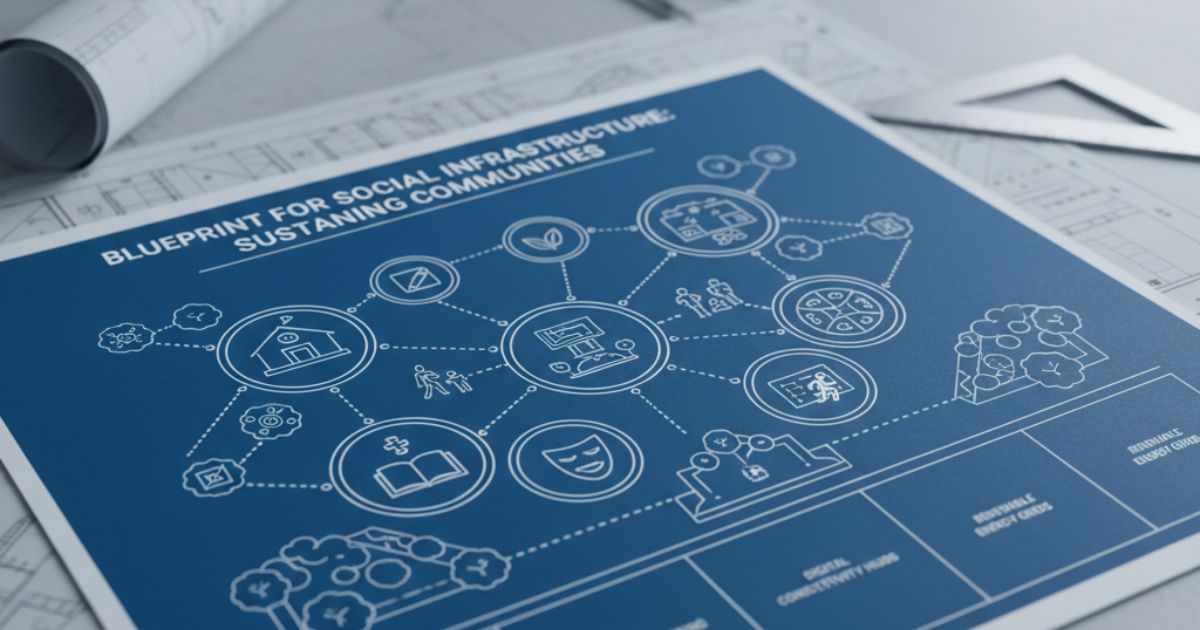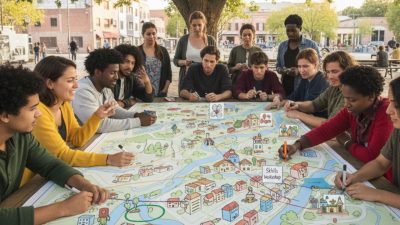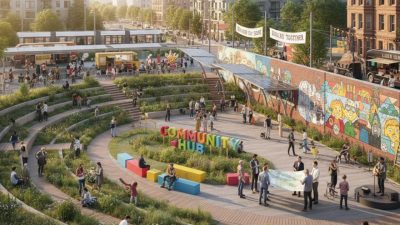Cities are growing fast, and people often feel more isolated than ever. Building strong, inclusive, and vibrant communities has become a top priority. Traditional community development typically focuses on infrastructure, such as roads and buildings, as well as employment opportunities and income. However, the real strength of a neighborhood lies in the connections, relationships, and shared experiences among its residents. This network of relationships is known as social infrastructure, and it enables communities to adapt, solve problems, and support one another in both good and challenging times.
Social infrastructure includes the places, organizations, and digital platforms where people meet, share ideas, and learn together. Community centers, parks, local nonprofits, and online forums are all examples of spaces that build social cohesion and encourage community engagement. These “third places” create trust, spark collaboration, and bring people together to improve their neighborhoods.
This blog post will define social infrastructure, explore its three main pillars, offer practical strategies for building it, provide real-world examples, and discuss methods for measuring success. By the end, you will have a clear blueprint to strengthen your community and create spaces—both physical and digital—where people can connect, grow, and thrive together.
Defining Social Infrastructure
Social infrastructure refers to the array of public, private, and hybrid spaces and programs that facilitate social interaction, knowledge exchange, and mutual support among community members. Unlike traditional infrastructure, which emphasizes physical assets like roads or utility networks, social infrastructure prioritizes the human connections that underpin civic engagement, well-being, and social cohesion. It encompasses:
- Physical gathering spaces (community centers, libraries, parks)
- Social systems and networks (volunteer organizations, neighborhood associations)
- Digital platforms (online forums, social media groups, mobile apps)
By intentionally designing and nurturing these elements, communities can cultivate trust, reduce isolation, and unlock collective intelligence to address local challenges—whether that’s improving educational outcomes, promoting environmental stewardship, or enhancing public safety.
The Three Pillars of Vibrant Communities

1. Physical Gathering Spaces
Physical spaces, such as community centers, public libraries, parks, and farmers’ markets, serve as vital nodes for social interaction. These venues host events, workshops, and informal gatherings where residents of diverse backgrounds can meet, exchange ideas, and build relationships. Well-designed public spaces are accessible, inclusive, and adaptable to various activities—from after-school programs to cultural festivals—that reflect the community’s unique identity and needs.
2. Social Systems and Organizations
Beyond bricks-and-mortar locations, social infrastructure relies on organizations, clubs, and volunteer networks that animate community life. Local nonprofits, faith-based groups, neighborhood associations, and cooperatives mobilize resources, drive initiatives, and offer support services. These entities also foster leadership development, empowering individuals to take ownership of projects that resonate with their passions and skills.
3. Digital Platforms
In a world where online interaction is ubiquitous, digital platforms extend the reach of social infrastructure beyond geographical boundaries. From neighborhood forums like Nextdoor to specialized apps for skill-sharing or civic engagement, these virtual spaces enable residents to coordinate events, announce local news, seek recommendations, and collaborate on community projects. Effective digital platforms strike a balance between moderation, transparency, and data privacy to maintain trust and inclusivity.
Strategies for Building Robust Social Infrastructure
- Engage Diverse Stakeholders: Involve residents, local businesses, nonprofits, and government agencies in co-creation workshops to ensure that social infrastructure meets varied needs and reflects shared priorities.
- Map Existing Assets: Conduct an asset-mapping exercise to catalog current physical spaces, organizations, and digital channels. Identify gaps and opportunities for new or enhanced interventions.
- Design Flexible Spaces: Develop multipurpose venues that can host educational classes, community meetings, health clinics, and cultural events, maximizing utilization and fostering cross-sector collaboration.
- Leverage Public-Private Partnerships: Collaborate with private developers, philanthropic foundations, and local governments to share resources, reduce risk, and scale successful models.
- Foster Volunteer Leadership: Create clear pathways for residents to volunteer, lead committees, and manage projects. Offer training, micro-grants, and recognition programs to sustain engagement.
- Integrate Online and Offline Activities: Use digital tools to promote in-person events and vice versa. For example, livestream community gatherings or organize virtual forums that feed into real-world action committees.
- Prioritize Accessibility and Inclusivity: Ensure that all community members, including seniors, individuals with disabilities, and non-native speakers, can participate. Provide multilingual resources, accessible design, and child care support at events.
- Secure Sustainable Funding: Explore diverse revenue streams such as membership fees, sponsorships, grants, and social enterprise ventures to finance ongoing operations and maintenance.
Implementing these strategies requires persistent coordination and adaptive management. It’s essential to establish governance structures that track progress, adjust plans based on feedback, and celebrate small wins to build momentum.
Case Studies in Community Development
Example 1: The Humboldt Park Cultural Center, Chicago – By transforming a historic building into a multipurpose hub, local leaders created a space for arts performances, workforce training, and youth mentorship programs. The initiative fostered cross-cultural dialogue between long-standing residents and recent immigrants, resulting in a 25% increase in volunteer participation over a two-year period.
Example 2: La Mesa Civic Commons, California – A public-private partnership revitalized an underutilized downtown plaza with Wi-Fi access, pop-up shops, and a mobile app for event scheduling and management. Foot traffic doubled, small business revenues increased by 15%, and surveys revealed a notable improvement in residents’ sense of belonging.
Example 3: Digital Ubuntu Network, South Africa – Leveraging affordable mobile technology, this grassroots platform connected rural communities with agricultural experts, health workers, and microfinance institutions. Farmers shared real-time market prices and farming tips via SMS, resulting in a 30% increase in crop yields and enhanced food security.
Example 4: The Green Corridors Initiative, London – By converting disused rail lines into linear parks and cycle routes, local councils partnered with grassroots activists to co-design public art, community gardens, and pop-up markets. The project not only increased recreational usage by over 75% but also spurred a 40% uptick in local startup formations, demonstrating how urban greening and social infrastructure can drive both well-being and economic vitality.
Overcoming Common Challenges
While the benefits of robust social infrastructure are clear, implementation can face several hurdles:
- Funding Constraints: Many community initiatives struggle to secure sustained financing, leading to incomplete projects and unmet promises. Mitigation: Diversify revenue streams through grants, sponsorships, and social enterprises.
- Political Fragmentation: Differing priorities among local governments, nonprofits, and residents can stall progress. Mitigation: Facilitate neutral and inclusive convening spaces and establish effective governance frameworks.
- Community Apathy: Residents may be hesitant to support new initiatives due to past disappointments. Mitigation: Engage community ambassadors, maintain transparency, and demonstrate quick wins.
- Maintenance and Sustainability: Both physical and digital platforms require ongoing maintenance and upkeep. Mitigation: Allocate dedicated maintenance budgets and train local volunteers for basic operations.
Strategies for mitigation include diversified funding, inclusive governance, targeted outreach campaigns, and maintenance plans embedded in budgets.
Emerging Trends in Social Infrastructure
As the landscape of community development evolves, several trends are reshaping how social infrastructure is conceptualized and deployed:
- Hybrid Physical-Digital Spaces: Integration of augmented reality (AR) experiences and Internet of Things (IoT) sensors in community hubs to enhance engagement and data collection.
- Data-Driven Community Design: Leveraging big data and geospatial analytics to tailor interventions based on real-time community needs and usage patterns.
- Climate-Resilient Community Hubs: Designing multipurpose spaces that double as emergency shelters, cooling centers, or flood-safe zones during natural disasters.
- Co-living and Co-working Models: Blurring the lines between residential, professional, and communal spaces to foster deeper, more sustainable connections.
- Equity-Centered Planning: Prioritizing historically marginalized groups in decision-making processes and resource allocation to ensure inclusive outcomes.
Staying abreast of these trends ensures that community builders can adapt their strategies to meet future challenges and capitalize on opportunities.
Practical Toolkit: Steps and Resources
Embarking on a social infrastructure initiative can feel daunting. Here’s a step-by-step toolkit to guide community builders:
- Stakeholder Mapping: Identify all potential stakeholders—from residents to regional policymakers. Utilize tools such as stakeholder matrices and power-interest grids.
- Community Surveys: Deploy both digital (SurveyMonkey, Google Forms) and analog (paper surveys, town hall forums) methods to gather comprehensive data on needs and preferences.
- Design Workshops: Facilitate co-creation sessions utilizing design thinking frameworks, including empathy mapping, journey mapping, and rapid prototyping.
- Pilot Programs: Launch small-scale pilots to test concepts. Monitor performance metrics and solicit feedback for iterative improvements.
- Evaluation Framework: Develop a Theory of Change, define short-term outputs and long-term outcomes, and set up a mixed-methods evaluation plan.
- Scaling Strategies: Document successful processes, create open-source toolkits, and establish replication grants to encourage adoption in neighboring communities.
Resources such as the Knight Foundation’s Community Information Challenge, the Rockefeller Foundation’s 100 Resilient Cities program, and local university extension services can provide technical support, grants, and training.

Measuring Impact and Success
Quantifying the benefits of social infrastructure is challenging but vital for justifying investments and guiding continuous improvement. Key performance indicators (KPIs) may include:
- Participation Rates: Attendance at events, membership growth, and repeat engagement metrics.
- Network Density: Number of partnerships formed among organizations and cross-sector collaborations.
- Social Capital Indicators: Survey-based measures of trust, reciprocity, and sense of belonging.
- Economic Outcomes: Changes in local business revenues, job creation, or access to training programs.
- Well-being Metrics: Community health statistics, self-reported quality-of-life scores, and reductions in social isolation.
Monitoring social capital can involve qualitative methods such as focus groups, story circles, and community-led photovoice projects, which capture narratives of trust and cooperation that numbers alone may miss. Combining these insights with GIS mapping of foot traffic flows and digital engagement analytics offers a holistic picture of how social infrastructure is performing over time.
Conclusion: A Call to Community Builders
Building vibrant, resilient, and inclusive communities takes more than buildings and roads. It requires a strong social infrastructure that connects people. By creating welcoming gathering spaces, supporting local organizations, and utilizing digital tools, we can foster communities where collaboration flourishes, new ideas flourish, and everyone has an opportunity to succeed.
Whether you are a local organizer, policymaker, or community supporter, your role is essential. Start by mapping your community’s strengths, listening to diverse voices, and testing small projects that can be scaled up over time. Track your results, celebrate your wins, and learn from challenges to continually improve.
Together, we can transform neighborhoods into supportive and lively environments that endure and inspire other communities.
Ready to take action? Share your ideas, join a local planning meeting, or partner with nearby organizations to make a positive impact. Strong communities are built through teamwork—and it begins with you.
For Further Reading, explore Mastering Community Onboarding





